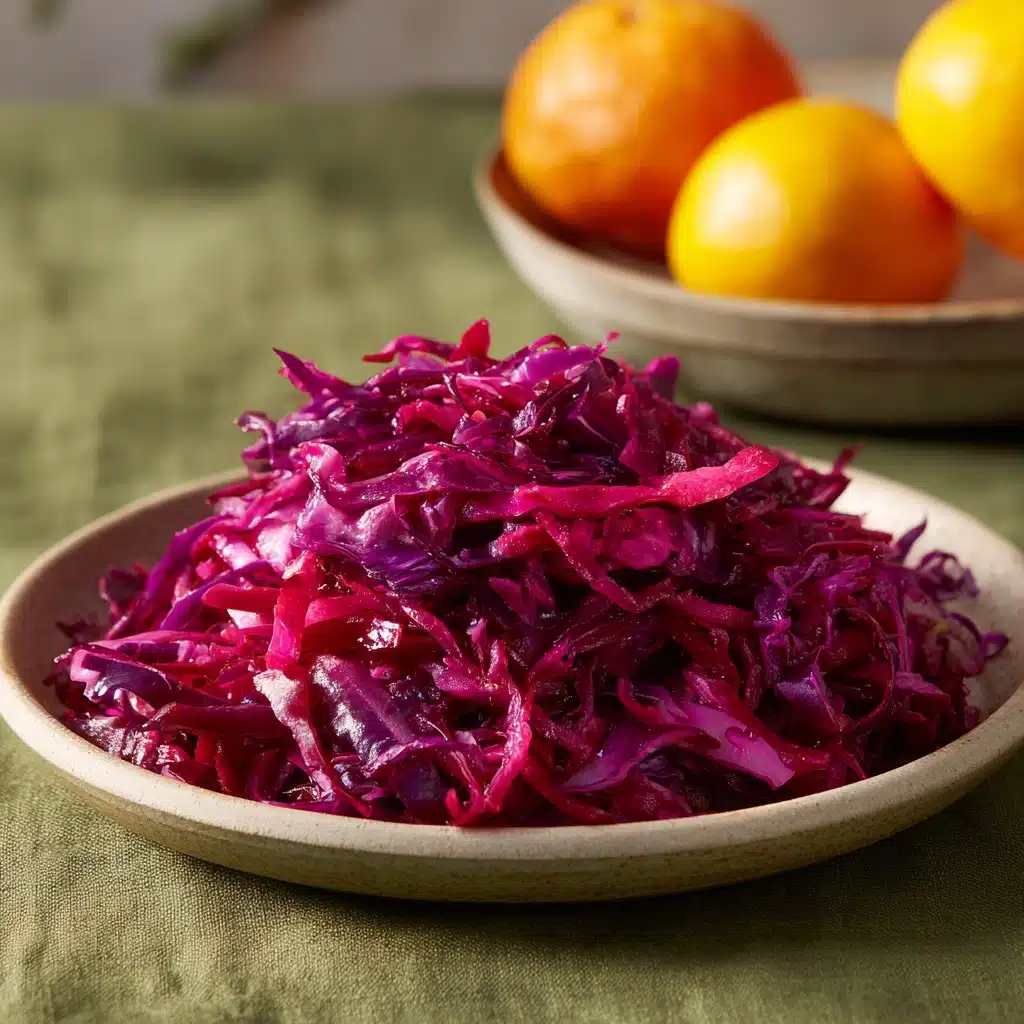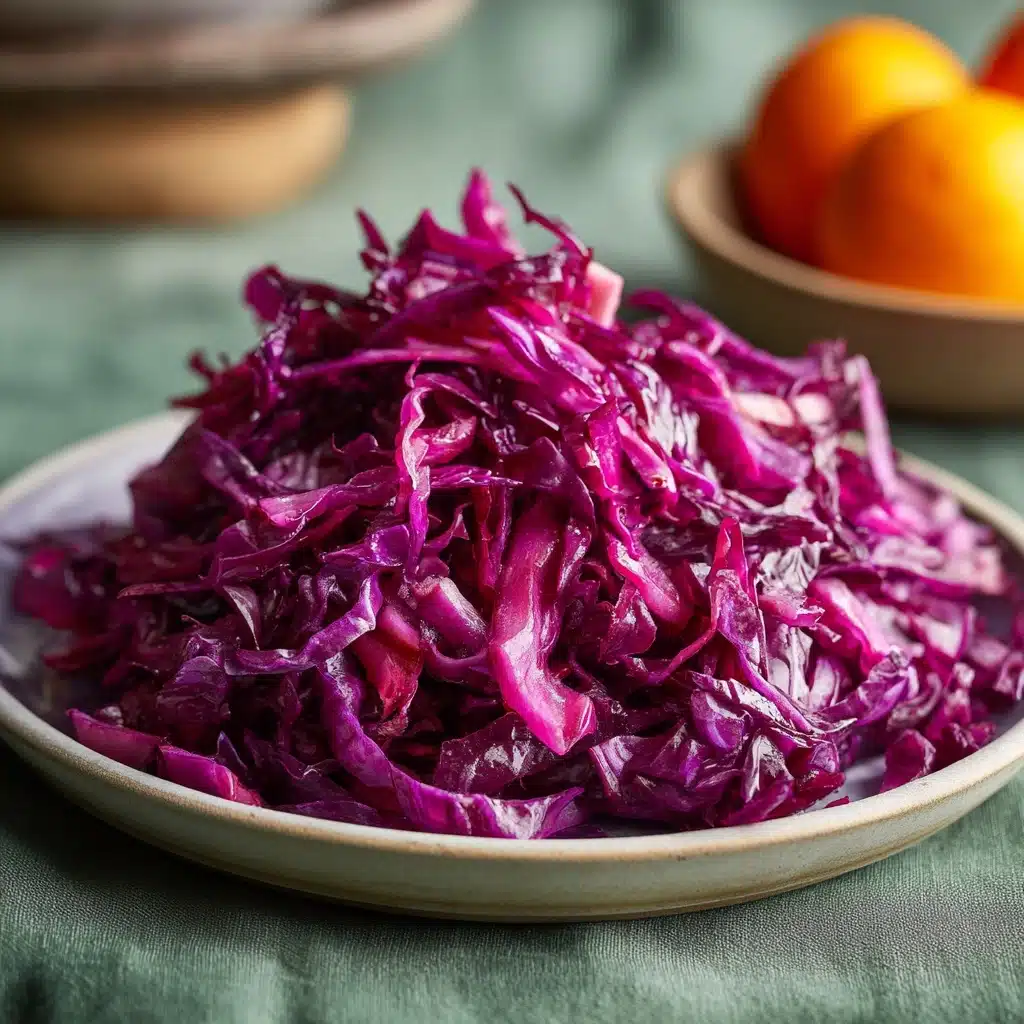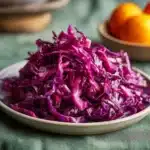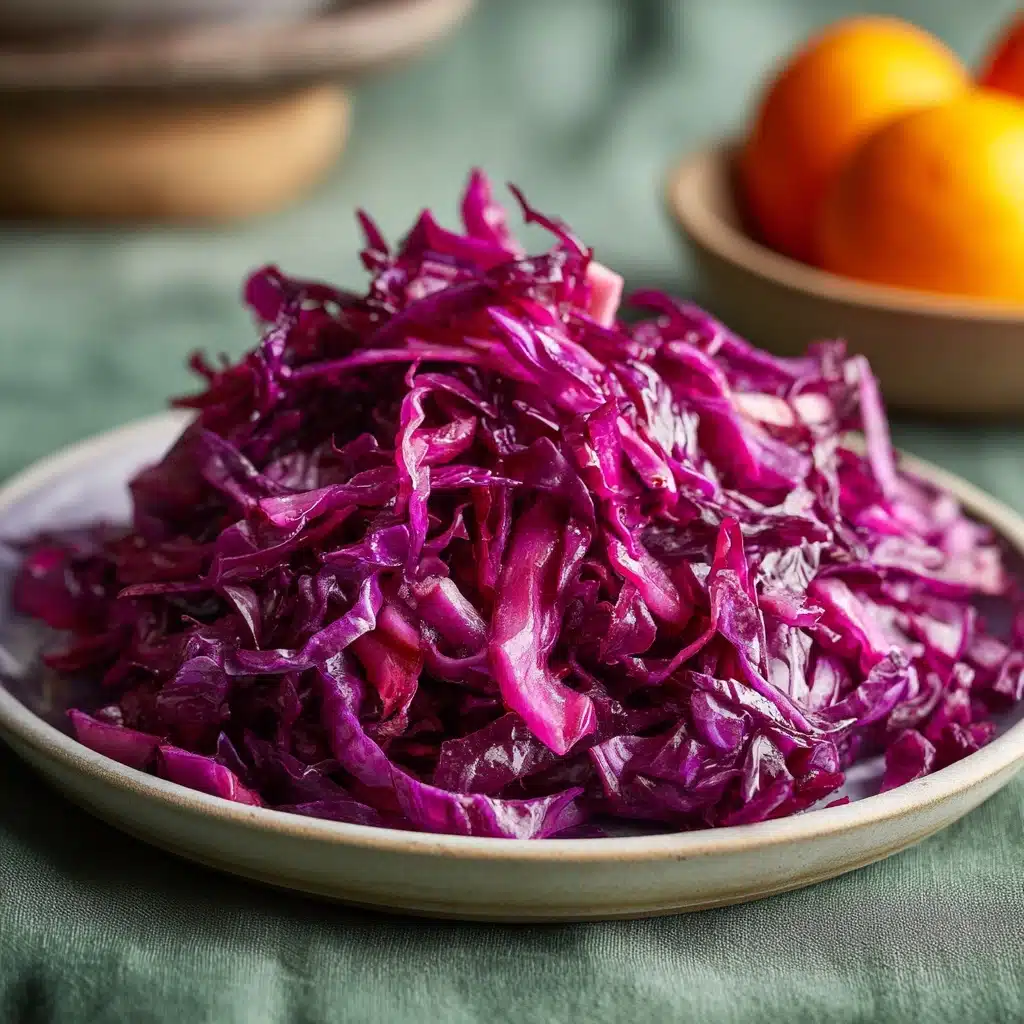Red Cabbage Sauerkraut is more than just a vibrant addition to any plate—it’s a zesty, probiotic-rich treasure with an irresistible crunch. This classic fermented dish, made simply with shredded cabbage, salt, and a dash of caraway or juniper, transforms a humble head of cabbage into a tangy, sparkling condiment that brightens sandwiches, sausages, salads, and so much more. The stunning magenta hue doesn’t just charm the eyes; it also promises an abundance of flavor and healthful goodness. Whether you’re new to fermenting or a seasoned kraut enthusiast, this recipe is the perfect way to bring tradition, nutrition, and color to your kitchen.

Ingredients You’ll Need
At the heart of this recipe are just a few thoughtfully chosen ingredients, each playing a crucial role in the taste, texture, and visual pop of Red Cabbage Sauerkraut. Their simplicity is part of the magic—every item draws out earthy, tangy flavors and ensures the kraut’s signature snap.
- Red cabbage: The star of the show, its rich color and sweet, peppery flavor make the final sauerkraut both beautiful and delicious.
- Sea salt (non-iodized): Salt draws out the cabbage’s moisture, creating brine and promoting fermentation—don’t use iodized salt or it may inhibit the good bacteria.
- Caraway seeds or juniper berries (optional): These add depth and a warm, aromatic note; use one or both, or skip for a more classic kraut.
How to Make Red Cabbage Sauerkraut
Step 1: Prep the Cabbage
Start by peeling away any bruised or damaged outer leaves from your cabbage. Slice the cabbage into quarters and trim out the tough stem and core from each section. A sharp chef’s knife, a mandoline, or even a food processor works perfectly for shredding—aim for fine, even ribbons. The more even your slices, the more uniformly your Red Cabbage Sauerkraut will ferment, resulting in the perfect mix of crunch and tang throughout every bite.
Step 2: Salt and Massage
Transfer the shredded cabbage into a giant mixing bowl, sprinkling it evenly with sea salt as you go. Now comes the fun part—massage the cabbage thoroughly with your hands for five to ten minutes. The salt will coax out the cabbage’s natural juices, and you’ll see the pile shrink and glisten as you go. This step is key to developing the brine that will protect and preserve your kraut through fermentation.
Step 3: Add Seasonings
Once your cabbage is shimmering and juicy, stir in your caraway seeds or juniper berries if desired. These little extras add just the right whisper of herbal warmth, making your Red Cabbage Sauerkraut uniquely addictive. Of course, if you prefer a super straightforward flavor, feel free to skip the extra seasoning for a pure, classic kraut.
Step 4: Pack Into Jar and Submerge
Grab a clean glass jar or traditional ceramic crock, and begin packing in your cabbage fistful by fistful. Press down as you go (your fist or a wooden tamper works great), ensuring you squeeze out air pockets and keep the cabbage submerged in its salty brine. Leave 1–2 inches of headspace at the top to give the kraut room to bubble and breathe. Place a weight or a smaller jar inside to keep everything nicely submerged below the brine—it’s the key to proper fermentation!
Step 5: Ferment and Wait
Cover your jar with a cloth, a fermentation lid, or a loose lid, and set it somewhere cool and out of direct sun—room temperatures between 65 and 75°F are ideal. Check your Red Cabbage Sauerkraut daily to ensure the cabbage stays below the brine (top up with a pinch of salted water if needed) and skim off any foam or scum that may appear. Taste after about a week; you can let it ferment from 1 up to 3 weeks, depending on how tangy and pungent you like your kraut!
Step 6: Chill and Store
When your sauerkraut has hit peak flavor, remove the weight and zap it into the fridge. The cool temperature slows fermentation and helps the flavors mellow and marry. Stored properly, your Red Cabbage Sauerkraut will stay crisp and crave-worthy for months—making it the ultimate “set it and forget it” fridge staple.
How to Serve Red Cabbage Sauerkraut

Garnishes
A sprinkle of fresh dill or chopped scallions makes a lovely finish on your Red Cabbage Sauerkraut. If you’re feeling extra, try a drizzle of good olive oil or a dusting of cracked black pepper—your bowl of kraut will look as fabulous as it tastes, with green flecks popping against that brilliant purple.
Side Dishes
Red Cabbage Sauerkraut is the ultimate partner to so many favorites—pile it high alongside roasted sausages, tuck it into grain bowls, or use it to brighten rich potato dishes. It’s unbeatable on a hearty sandwich or burger, and just as delightful spooned over grilled meats, tofu, or even simple scrambled eggs.
Creative Ways to Present
For a showstopping appetizer, layer your kraut with creamy hummus and crunchy veggies in a mason jar or serve it atop crispy crostini. Swirl a little into slaws for extra zip, or toss with roasted root veggies for a color explosion. With Red Cabbage Sauerkraut, even the simplest snack turns into a work of art!
Make Ahead and Storage
Storing Leftovers
Pack any leftover Red Cabbage Sauerkraut into a clean, airtight jar and store it in the fridge. It will keep its crunch and tang for several months, and in fact, the flavors get even more complex as it mellows. Always use clean utensils to scoop, and make sure the kraut stays submerged in brine to keep it fresh and zesty.
Freezing
While it’s not commonly frozen (the crunch may soften a bit), you absolutely can freeze extra kraut! Portion the Red Cabbage Sauerkraut into freezer-safe bags or containers, squeeze out as much air as possible, and freeze for up to three months. Thaw in the fridge overnight before using—just keep in mind it’s best in cooked dishes after freezing.
Reheating
Sauerkraut is typically enjoyed cold or at room temperature, but if you want to warm it for a hearty meal, gently heat in a skillet over low heat. Add a splash of water or broth if needed to prevent sticking. Just avoid boiling or overcooking, as that can dull both its color and probiotics.
FAQs
Can I add other vegetables to my Red Cabbage Sauerkraut?
Absolutely! Grated carrots or thinly sliced apples are popular additions that bring sweet crunch and a touch of fruitiness. Other options include fennel, beets, or even a handful of fresh herbs—just be sure to maintain the basic salt-to-cabbage ratio for safe fermentation.
What if my sauerkraut turns slimy or smells bad?
If you notice an unpleasant odor or a slimy texture, it’s best to discard the batch. Proper fermentation only produces a pleasantly sour, clean aroma—anything rotten or off is a sign things haven’t gone as planned. Clean equipment and enough salt will help keep your Red Cabbage Sauerkraut safe and delicious.
Do I need special equipment to make kraut?
No fancy gadgets required! While a fermentation crock is lovely, a wide-mouth glass jar works just as well. You will want a weight to keep the cabbage submerged (a smaller jar filled with water, a fermentation weight, or even a zip-top bag of brine will do the trick).
Why is non-iodized salt recommended?
Non-iodized salt is crucial because regular table salt can inhibit the beneficial bacteria that ferment your cabbage. Sea salt, pickling salt, or kosher salt (without anti-caking agents) help create the best environment for safe, flavorful Red Cabbage Sauerkraut.
How do I know when my sauerkraut is ready?
Taste is your guide! After about a week, start sampling your sauerkraut daily. Once it’s tangy enough for your liking (anywhere from 7 to 21 days), move it to the refrigerator. Fermentation slows in the cold, locking in that perfect, snappy flavor.
Final Thoughts
If you’ve never tried making Red Cabbage Sauerkraut at home, there’s no better moment to dive in. It’s easy, rewarding, and guaranteed to bring sparkle and satisfaction to all sorts of everyday meals. Give it a go—the process is half the fun, and the tangy payoff is absolutely worth it!
Print
Red Cabbage Sauerkraut Recipe
- Total Time: 15 minutes plus 1–3 weeks fermenting
- Yield: About 1 quart 1x
- Diet: Vegan, Gluten-Free, Paleo
Description
Learn how to make delicious red cabbage sauerkraut at home with this easy recipe. Fermented to perfection, this tangy and colorful sauerkraut is a great addition to any meal.
Ingredients
Red Cabbage Sauerkraut Ingredients:
- 1 medium head red cabbage (about 2 pounds), finely shredded
- 1 1/2 tablespoons sea salt (non-iodized)
- 1 teaspoon caraway seeds or juniper berries (optional)
Instructions
- Prepare the Cabbage: Remove any damaged outer leaves, quarter the cabbage, remove the core, and finely shred.
- Create the Brine: Massage the cabbage with sea salt until it releases liquid, then mix in caraway seeds or juniper berries.
- Ferment the Sauerkraut: Pack the cabbage into a jar, ensuring it’s submerged in brine, and let it ferment for 1–3 weeks.
- Store: Once tangy enough, transfer to the refrigerator for long-term storage.
Notes
- Use non-iodized salt for the best results.
- Enhance with grated carrot or sliced apple for added flavor.
- Prep Time: 15 minutes
- Cook Time: 0 minutes
- Category: Condiment, Side Dish
- Method: Fermenting
- Cuisine: German, Eastern European
Nutrition
- Serving Size: 1/4 cup
- Calories: 15
- Sugar: 2g
- Sodium: 200mg
- Fat: 0g
- Saturated Fat: 0g
- Unsaturated Fat: 0g
- Trans Fat: 0g
- Carbohydrates: 3g
- Fiber: 1g
- Protein: 1g
- Cholesterol: 0mg







